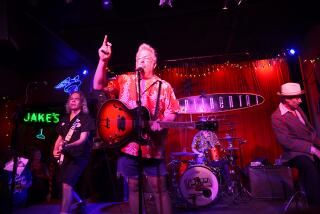Nixon Library Hits Close to Home : Architecture: Simple red-tiled pavilions and a reflecting pool are as unpretentious as the clapboard farmhouse where the former President was born.
- Share via
A simple yet moving image shapes the design of the new Richard M. Nixon Library and Birthplace--the image of the great leap the former President made from a small white clapboard farmhouse to the pinnacle of power in the White House.
Perched on a knoll shaded by pepper trees, the 1913 Nixon house--reputedly ordered from a Sears catalogue--is an architectural counterpoint to the smart new library down the hill. The axis of the long reflecting pool that lies at the center of the new library points straight to the President’s boyhood home and the bed in which he was born.
“Nixon’s journey from humble obscurity to national leadership is a central symbol in the way the library was laid out on the site,” said library architect Richard Poulos. “The little house on the hill is the emotional anchor of the design.”
The Nixon library is in many ways an extension of the President’s home. Its character is muted, carefully crafted and very much in tune with the shady suburban streets that surround it.
Designed by Langdon Wilson Architecture & Planning, a national firm headquartered in Newport Beach, the library is a fine and appropriate building with no pretensions of being a great act of architecture. Its style expresses the down-home, ordinary-guy side of Nixon’s character rather than the ambiguities of his complex soul.
Nixon made two major demands upon the architectural character of the library, Poulos said.
“He wanted a traditional, not a modernist building, and he insisted that the library create a welcoming atmosphere that would encourage people to visit and often return.”
Composed of three low, red-tiled pavilions grouped around the reflecting pool, the complex breathes an air of domestic tranquility.
Clad in warm red Arizona sandstone set between a plinth of buff-colored cement plaster and a recessed band of black slate under the roof line, the library’s architecture is truly welcoming and unmonumental. Its character continues the unpretentious tradition of most of the eight other presidential libraries.
The $14-million Nixon library is closer in spirit to such humble structures as the 1916 Rutherford B. Hayes Library in Fremont, Ohio--the first presidential archive--or Harry S. Truman’s library in Independence, Mo., rather than the inspirational monumentality of the John F. Kennedy library in Dorchester, Mass.
The Kennedy library, designed by noted architect I.M. Pei, is a stark white concrete mausoleum set off by a 112-foot-high atrium enclosed in black glass overlooking Boston Harbor. Fit for a Pharaoh, the Kennedy library “makes it hard to believe that Mr. Kennedy was anything but a man of energy, of zest, of confidence,” one architectural critic commented.
In contrast, the Nixon library makes no attempt to overwhelm the public with its importance.
One of the first features a visitor sees on arriving at the library is a grove of orange trees flanking the entrance. The grove not only softens the hard surfaces of the architecture, but also recalls the site’s original purpose as the citrus farm of Frank Nixon, the former President’s father.
The parking lot surrounding the library is landscaped with terraces, patterned paving and a lush fountain. Gentle steps lead up to the main entrance on the southeast corner of the site, through an entry portico and into the generous lobby.
For security reasons, the visitor’s progress through the library is firmly but discreetly directed throughout the complex.
“To accommodate visitors while protecting the safety of the archival materials, we must control the way people move through the building,” said attorney Hugh Hewitt, the library’s acting executive director. “We want to operate this control discreetly but firmly.”
In the lobby, a granite-topped reception desk directs the circulation. Under the lobby pavilion’s high, peaked ceiling--the shape mimicking the configuration of a Quaker meeting hall of the kind the Nixon family frequented--is an array of panels displaying the library layout.
An east wall of glass frames a charming vista along the length of the reflecting pool to the grassy knoll on which the Nixon house sits.
The Roman-style formality of the pool and its bordering trellis and colonnade make a touching contrast with the humble silhouette of the original farmhouse seen in the middle distance.
The opposite lobby wall is lined with a curving panel of bird’s-eye maple that hides the restrooms and small gift shop tucked into a corner. Alabaster chandeliers and indirect cove lighting soften the hard surfaces of the terrazzo floors.
The lobby will also host temporary exhibits, such as a collection of Winston Churchill’s paintings or jazz genius Duke Ellington’s memorabilia.
The average visitor, who, it is estimated, will spend about two hours going through the library, next proceeds to the 300-seat theater flanking the lobby.
In this pleasant paneled space, carpeted in Nixon’s favorite dark blue, the audience can see a 25-minute orientation film covering the President’s life.
The theater is also intended for lectures and debates. “We may even restage the famous argument between William Buckley and Gore Vidal--a Nixon-lover and a Nixon-hater,” Hewitt said. “The President himself suggested it.”
Between the theater and the exhibit hall is a gallery displaying the 67 Time magazine covers that featured Nixon through his long political career. These drawings, caricatures and photos are a vivid shorthand record of a remarkable man’s odyssey through one of the nation’s most troubled periods.
The exhibit hall is the most demanding sequence in the visitor’s journey through the library.
Alternating “hard” rooms charged with information and “soft” rooms with evocative scenarios, the exhibit hall is a concentrated and detailed record of Nixon’s public life, designed by Demartin Marona Cranstoun Downes.
“The Road to the Presidency” begins the journey with an evocation of the post-World War II era. A 1949 Ford Mercury station wagon with butter-yellow panels has a cardboard cutout of Nixon perched on the tailgate while delivering a political speech.
This scenario leads into a curving wall of text and photos covering Nixon’s vice presidency, which in turn opens into a cubicle dominated by a giant TV replaying the famous Nixon-Kennedy debates of the 1960 presidential campaign.
In each space the ceiling is raised or lowered, to heighten or reduce the feeling of intimacy. Because most Americans saw the innovative 1960 TV debates in their living rooms, the ceiling here is low and domestic. Where the scenes are more public, the ceilings are higher.
The highest ceiling, lit by a series of skylights, is in the World Leaders room.
Here plaster casts of 10 world leaders, selected by Nixon for their influence on his career and his thinking, line the walls. Ranging from a lofty Charles de Gaulle to a dumpy Golda Meir, the figures offer a homey gallery of the personalities populating the President’s past.
An interactive, touch-screen video display allows one to learn about the leaders before plunging into the darkened chamber titled Foreign Affairs.
Blinking in the transition from bright natural sunshine, the visitor discerns the outlines of glittering, gilded re-creations of Beijing’s China Gate and Moscow’s St. Basil’s Cathedral.
Tucked away among the glories is a mock-up of the living room of a typical Middle-American suburban tract home in which many people might have watched Nixon’s encounters with the likes of Mao Tse-tung and Nikita S. Khrushchev.
The next space offers a relief from the weight of world history.
Titled the Pat Nixon Area, this long gallery is lit by a bank of windows that offer yet another vista of the Nixon house beyond a terraced rose garden. Display cases hold photos of scenes from the Nixons’ life in the White House, and a side chamber re-creates the Lincoln sitting room that was the former First Family’s favorite White House hideaway.
Beyond the gallery a room devoted to domestic affairs leads through the 1972 presidential campaign into the Watergate era.
The long and constricted Watergate room is “deliberately painful,” Hewitt said. Headline texts above eye level top photos mounted on back-lit glass panels, culminating in the agonizing moment when Nixon waved goodby to the presidency in the doorway of a helicopter parked on the White House lawn.
Not wanting to end on that note, the designers added a final room with videos of 500 taped questions about Nixon’s presidency. Electronic screens allow participants to call up a question and have Nixon appear on a screen to answer it.
Coming out of the intensive experience of the exhibit hall, the visitor finds relief in the landscaping. Designed by Emmet Wemple & Associates, the formal gardens will in time grow out into a lush setting framing the library’s pavilions.
A restricted basement area contains the staff offices and the scholars’ reading room.
In this subterranean space designer Gere Kavanaugh has created a serene atmosphere conducive to study. Glass walls allow the staff to keep an eye on the valuable documents and objects in the adjoining storerooms.
Nixon’s choice of Langdon Wilson to design his library was a shrewd one. Among the largest architectural practices in the United States, Langdon Wilson has created such diverse local landmarks as the Roman villa-style J. Paul Getty Museum in Malibu, the glass-walled CNA building near MacArthur Park and the Jamboree Center in Irvine.
According to Poulos, who heads the firm’s Newport Beach office, Nixon is “very enthusiastic” about the look of the library. “He says it expresses exactly what he wanted to say to posterity, about his accessibility and simplicity of style,” Poulos said.
The architecture skillfully and subtly embodies this intention. Its symbolism is discreet, its manner unassertive, its style perfectly matched to its suburban surroundings.
The Nixon library is a thoroughly likable, perfectly realized--though possibly oversimplified--monument to a very complicated public man.
More to Read
The biggest entertainment stories
Get our big stories about Hollywood, film, television, music, arts, culture and more right in your inbox as soon as they publish.
You may occasionally receive promotional content from the Los Angeles Times.










